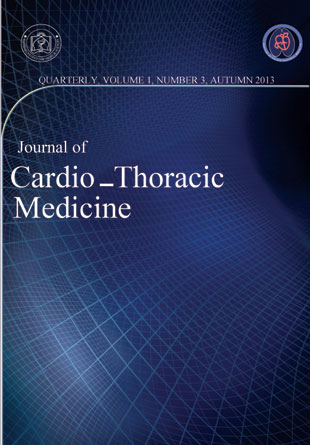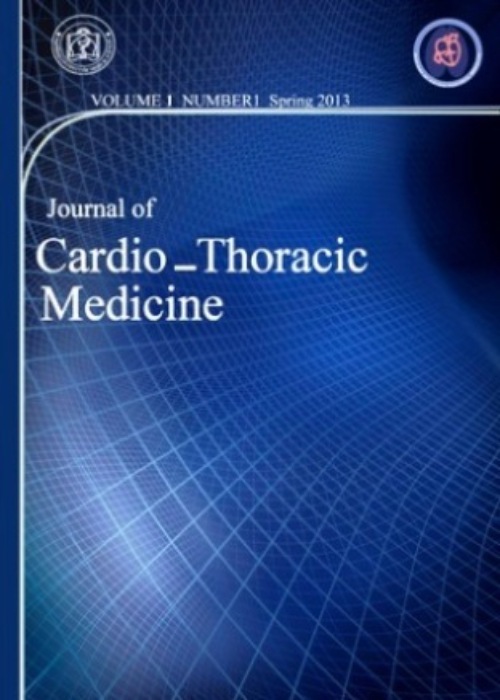فهرست مطالب

Journal of Cardio -Thoracic Medicine
Volume:1 Issue: 3, Autumn 2013
- تاریخ انتشار: 1392/08/11
- تعداد عناوین: 9
-
-
Page 72Dear colleagues, It is my pleasure to welcome you in the third issue of Journal of Cardio-Thoracic Medicine and I hope you find it interesting. In this issue, beside the valuable original articles and an interesting case report, a useful review article have been published concerning the role of nuclear medicine in the management of solitary pulmonary nodule.I am proud to announce you that Journal of Cardio-Thoracic Medicine has been approved by Medical Journal Commission of Ministry of Health and Medical Education to be a Scientific Research Journal.Additionally Journal of Cardio-Thoracic Medicine is now indexed in DOAJ, EBSCO, Index copernicus, ISC, Magiran.Hopefully, the Journal of Cardio-Thoracic Medicine helps you through conveying your valuable experiences in the field of cardio-thoracic medicine. We kindly ask our readers to share their opinions for exploring new ways to make the journal more useful and practical.Finally, I would like to thank all of our dear authors for submitting their articles.
-
Pages 73-78Solitary pulmonary nodule (SPN) is a frequent finding on the chest x-ray and computed tomography. Nuclear medicine techniques play an important role in the diagnosis and management of SPN. In the current review, we briefly will explain the different nuclear medicine modalities in this regard including positron emission tomography (PET) using 18-F-FDG, and 11-C-Methionine, and single photon emission computerized tomography (SPECT) using somatostatin receptor scintigraphy, 201-Thallium, and 99m-Tc-MIBI.Keywords: FDG, PET, Scintigraphy Receptor, Somatostatin
-
Pages 79-83IntroductionNeurogenic mediastinal tumors comprise a wide range of benign and malignant diseases. A group of these tumors, located at thoracic apex, sometimes spread to cervical spaces causing numerous surgical difficulties. In thoracotomy approaches, due to proximity of the tumors to major blood vessels, complete removal of these tumors from cervical spaces is impossible or may cause intraoperative severe bleeding or other dangerous incidents Because of the adjacent major vessels that are not visible.The aim of this study is to report cases of surgical treatment of such tumors using Anterior Trans Cervicothoracic Approach (ATCA).Materials And MethodsAll patients with neurogenic tumors and cervicomediastinal (CM) spread who underwent surgey with ATCA technique during 2005-2011 were included in our study. Then they were evaluated in terms of age, sex, clinical symptoms, radiological and pathological findings, technical success rate of the surgery, surgical complications and first-year relapse rate after the surgery.ResultsOur study included 10 patients from whom 9 were female and 1 was male (M/F= 1/9) and the mean age was 27 years. The most common symptoms were pain and feeling of a lump. All patients were operated by this technique successfully. The most common pathological finding was neurofibroma (in 5 patients) and surgical complications occurred in 2 patients (20%) (Wound infection in 1 patient and brachial plexus injury in another patient). There was no mortality. Disease relapse was reported in 1 patient ganglioneuroblastoma who underwent surgical resection for the second time.ConclusionConsidering the successful removal of the tumors and favorable exposure of major vessels in cervicomediastinal spaces, this technique is recommended to resect mediastinal tumors with spread to cervical spaces. However, a more definite conclusion requires further studies.Keywords: Anterior Cervicothoracic Approach, Cervicomediastinal Tumor, Mediastinal Tumor
-
Pages 84-88IntroductionRecently a relation between female sex hormones and severity of asthma symptoms has been proposed. As a common endocrine dysfunction, polycystic ovary syndrome (PCOS) could significantly influence the level of sex hormones in PCOS patients. Regarding the possible role of sex hormones in airway physiology, the present study was conducted to survey the effects of PCOS on pulmonary function test parameters.Materials And MethodsIn this cross-sectional study 30 recently diagnosed patients with PCOS without history of pulmonary disease were enrolled and 20 healthy women were considered as the control group according to their age, weight, and height. The patients and the controls underwent body plethysmography to measure pulmonary function tests.ResultsThe mean age of the patients and the controls were 29.43±7.8 and 30.0±7.6 years respectively. There were no statistically significant differences in all pulmonary function test parameters between the patients and the controls (p>0.05). After dividing the patients into 2 groups based on their body mass index (BMI), BMIConclusionOur results showed that pulmonary function test parameters are not different in PCOS patients comparing to healthy women. Only the deleterious effects of high BMI on pulmonary function can be occurred in these patients.Keywords: Bodyplethysmography, Polycystic Ovary Syndrome, Pulmonary Function Test, Sex Hormones
-
Pages 89-94IntroductionAccording to the latest statistical and epidemiological studies, COPD will become the fourth leading cause of death in 2030 worldwide. Scientists are studying on methods to diagnose COPD in the patients in early stages, because it is a curable and preventable disease in early stages. In this study, evidences of hyperinflation on CXR of COPD patients were compared with pulmonary function test (PFT) finding.Materials And MethodsThis cross-sectional study was done on 100 patients who were referred to the pulmonary clinic with symptoms of chronic cough and dyspnea. After taking history and performing physical examination, demographic information, history of smoking and bakery and frequency of exacerbations were recorded. Standard spirometry was performed and the severity of COPD was determined by GOLD (Global initiative for chronic Obstructive Lung Disease) staging. Additionally, they underwent CXR examination (PA and lateral). Collected data were analyzed in SPSS ver. 18.ResultsIn this study, there were 79 male and 21 female.. .. . The patients, 64% of whom were urban and 36% were rural dwellers. There was significant correlation between FEF50%predict with sterno-diafragmatic angle and retro-sternal lucency (p=0.01, r=-0.26 and p=0.01, r=-0.25 respectively). Also there were significant correlations between the FEV1/FVC with retro-sternal lucency (p=0.006, r=-0.27) and FEV1%predict with sterno-diaphragmatic angle (p=0.002, r=-0.31).ConclusionThe study showed some evidences of lung hyperinflation on CXR which significantly associated with PFT parameters. Sterno-diaphragmatic angle and retro-sternal lucency can be used to predict the severity of airway obstruction in patients with COPD, although the CXR finding cannot be substituted for PFT and CT data.Keywords: Air Trapping, COPD, CXR, FEV1
-
Pages 95-99IntroductionThe objective of this study was to give a description of the most prominent atypical radiological presentations of lung hydatidosis.Materials And MethodsAll patients diagnosed with pulmonary hydatidosis by surgical exploration were included in this study. Standard chest roentgenogram and computed tomography CT) were evaluated before surgery for lung cysts or unknown lesions. Radiological findings were divided into two categories: 1- Typical hydatid cysts that were previously presented by imaging as a hydatid cyst in the form of an intact cyst, water lily sign and crescent sign. 2- Atypical hydatid cysts that were not similar to typical previously mentioned hydatid cysts.ResultsDuring a 26-year period, 1024 subjects with pulmonary hydatidosis were diagnosed and operated on. Chest X-rays (interpreted in 832 cases) showed perforated cysts in 190 (23%) and atypical findings such as mass, alveolar type infiltration, abscess and collapse in 113 (13%) patients. Seventy-nine patients had a thoracic CT scan in which atypical cysts were detected in 32 subjects (40.5%) such as: thick wall cavity in 9 patients (28%), solid masses in 7 (21%), abscesses in 6 (18%), consolidation in 3 (9%), fungus balls in 3 (9%), collapse (atelectasis) in 2 (6%) and round pneumonia in 2 (6%). Cavity was significantly more frequent in the right lung (90%) and mass-like opacity was significantly more frequent in the lower lung field (100%).ConclusionHydatid cysts should be considered for most of localized radiological pictures of the lung without respect to localization, size and count of lesions.Keywords: Chest Roentgenogram, Computed Tomography, Hyadtid cyst, Hydatidosis, Radiology
-
Pages 100-103IntroductionInteraction between drugs represents a major clinical concern for health care professionals and their patients. Patients affected by both type 2 diabetes and epilepsy may be prescribed pioglitazone and an anti-epileptic drug such as phenytoin concurrently. The aim of this study was to consider the interaction of pioglitazone with phenytoin in an experimental model. According to the result of this study, concurrent use of phenytoin and pioglitazone in clinic may cause therapeutic failure of phenytoin which may cause seizures and during seizures the cardiac function may be affected.Material And MethodsTwo groups of rats were treated for 30 days. In group 1 (control group) saline (10 ml/kg) and phenytoin (30 mg/kg) were administered daily by intragastric gavage. In group 2 (test group), pioglitazone (10 mg/kg) was administered daily 60 minutes before phenytoin (30 mg/kg). Two hours after the last intragastric gavage, animals were anesthetized with ether and 2 ml of blood was drawn from the heart into a syringe containing Ethylenediaminetetraacetic (EDTA), and phenytoin concentration in rat plasma was determined by High performance liquid chromatography (HPLC).The study consisted of 2 groups of 10 male adult Wistar rats.ResultsCompared with control group, concurrent use of pioglitazone and phenytoin was associated with significantly lower mean plasma concentrations of phenytoin: 2.08 ± 0.03 µg/ml VS 1.2 ± 0.02 µg/ml.ConclusionConcurrent use of pioglitazone and phenytoin was associated with a significant decrease in plasma concentration of phenytoin in this experimental model. In clinic, this interaction may cause seizures and it has been shown that both cardiac and respiratory functions may affected by seizures.Keywords: Drug Interaction, Phenytoin, Pioglitazone, Plasma level, Rats
-
Pages 104-106Although lightning is an uncommon phenomenon in nature; it can cause many destructive incidents. In the event of a lightning strike, multiple organs particularly the cardiovascular systems are at risk of injury. Short-term mortality depends on its cardiac effects. In this paper, the authors report the development of myocardial infarction and pericardial effusion after lightning injury, a typical example of “side splash”.Keywords: Lightening Injury, Myocardial Infarction, Pericardial Effusion
-
Page 107A 25 year-old Construction worker underwent neck laceration following penetrating neck trauma in a falling incident. The 3rd tracheal ring was injured which was initially repaired and the patient was discharged in good general condition. (Figure 1 shows the patient’s neck view after discharge from hospital).Two months later the patient was again admitted due to provocative coughing and a metal foreign body was detected in his right main bronchus. (Figure 2 shows CXR of the patient and Figure 3 demonstrates CT scan of the same patient). Finally the patient underwent rigid bronchoscopy to remove the foreign body. (Figure 4 shows the foreign body after rigid bronchoscopy).Keywords: Metallic Foreign Body, Neck, Penetrating Trauma, Trachea


